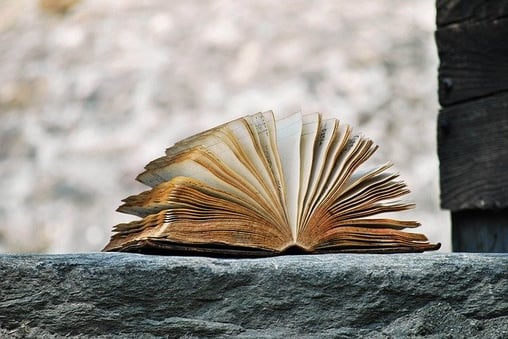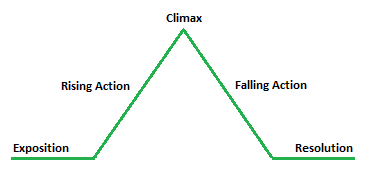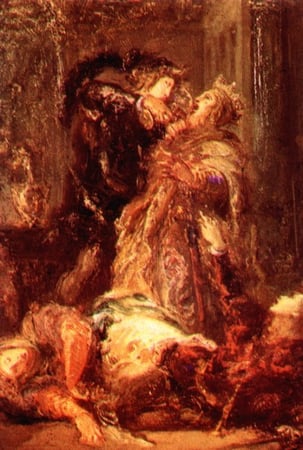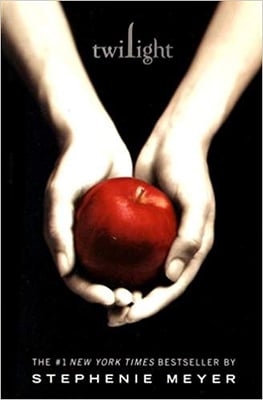
When we talk about stories, we tend to use the word "plot." But what is plot exactly? How does it differ from a story, and what are the primary features that make up a well-written plot? We answer these questions here and show you real plot examples from literature. But first, let’s take a look at the basic plot definition.
What Is Plot? Definition and Overview
What is the plot of a story? The answer is pretty simple, actually.
Plot is the way an author creates and organizes a chain of events in a narrative. In short, plot is the foundation of a story. Some describe it as the "what" of a text (whereas the characters are the "who" and the theme is the "why").
This is the basic plot definition. But what does plot do?
The plot must follow a logical, enticing format that draws the reader in. Plot differs from "story" in that it highlights a specific and purposeful cause-and-effect relationship between a sequence of major events in the narrative.
In Aspects of the Novel, famed British novelist E. M. Forster argues that instead of merely revealing random events that occur within a text (as "story" does), plot emphasizes causality between these events:
"We have defined a story as a narrative of events arranged in their time-sequence. A plot is also a narrative of events, the emphasis falling on causality. 'The king died and then the queen died,' is a story. 'The king died, and then the queen died of grief' is a plot. The time-sequence is preserved, but the sense of causality overshadows it."
Authors typically develop their plots in ways that are most likely to pique the reader’s interest and keep them invested in the story. This is why many plots follow the same basic structure. So what is this structure exactly?
What Is Plot Structure?
All plots follow a logical organization with a beginning, middle, and end—but there’s a lot more to the basic plot structure than just this. Generally speaking, every plot has these five elements in this order:
- Exposition/introduction
- Rising action
- Climax/turning point
- Falling action
- Resolution/denouement
#1: Exposition/Introduction
The first part of the plot establishes the main characters/protagonists and setting. We get to know who’s who, as well as when and where the story takes place. At this point, the reader is just getting to know the world of the story and what it’s going to be all about.
Here, we’re shown what normal looks like for the characters.
The primary conflict or tension around which the plot revolves is also usually introduced here in order to set up the course of events for the rest of the narrative. This tension could be the first meeting between two main characters (think Pride and Prejudice) or the start of a murder mystery, for example.
#2: Rising Action
In this part of the plot, the primary conflict is introduced (if it hasn’t been already) and is built upon to create tension both within the story and the reader, who should ideally be feeling more and more drawn to the text. The conflict may affect one character or multiple characters.
The author should have clearly communicated to the reader the stakes of this central conflict. In other words, what are the possible consequences? The benefits?
This is the part of the plot that sets the rest of the plot in motion. Excitement grows as tensions get higher and higher, ultimately leading to the climax of the story (see below).
For example, in Harry Potter and the Sorcerer’s Stone, the rising action would be when we learn who Voldemort is and lots of bad things start happening, which the characters eventually realize are all connected to Voldemort.
 This little guy says his cousin was part of the plot in the Harry Potter books.
This little guy says his cousin was part of the plot in the Harry Potter books.
#3: Climax/Turning Point
Arguably the most important part of a story, the climax is the biggest plot point, which puts our characters in a situation wherein a choice must be made that will affect the rest of the story.
This is the critical moment that all the rising action has been building up to, and the point at which the overarching conflict is finally addressed. What will the character(s) do, and what will happen as a result? Tensions are highest here, instilling in the reader a sense of excitement, dread, and urgency.
In classic tales of heroes, the climax would be when the hero finally faces the big monster, and the reader is left to wonder who will win and what this outcome could mean for the other characters and the world as a whole within the story.
#4: Falling Action
This is when the tension has been released and the story begins to wind down. We start to see the results of the climax and the main characters’ actions and get a sense of what this means for them and the world they inhabit. How did their choices affect themselves and those around them?
At this point, the author also ties up loose ends in the main plot and any subplots.
In To Kill a Mockingbird, we see the consequences of the trial and Atticus Finch’s involvement in it: Tom goes to jail and is shot and killed, and Scout and Jem are attacked by accuser Bob Ewell who blames their father for making a fool out of him during the trial.
#5: Resolution/Denouement
This final plot point is when everything has been wrapped up and the new world—and the new sense of normalcy for the characters—has been established. The conflict from the climax has been resolved, and all loose ends have been neatly tied up (unless the author is purposely setting up the story for a sequel!).
There is a sense of finality and closure here, making the reader feel that there is nothing more they can learn or gain from the narrative.
The resolution can be pretty short—sometimes just a paragraph or so—and might even take the form of an epilogue, which generally takes place a while after the main action and plot of the story.
Be careful not to conflate "resolution" with "happy ending"—resolutions can be tragic and entirely unexpected, too!
In Romeo and Juliet, the resolution is the point at which the family feud between the Capulets and Montagues is at last put to an end following the deaths of the titular lovers.

What Is a Plot Diagram?
Many people use a plot diagram to help them visualize the plot definition and structure. Here’s what a basic plot diagram looks like:

The triangular part of the diagram indicates changing tensions in the plot. The diagram begins with a flat, horizontal line for the exposition, showing a lack of tension as well as what is normal for the characters in the story.
This elevation changes, however, with the rising action, or immediately after the conflict has been introduced. The rising action is an increasing line (indicating the building of tension), all the way up until it reaches the climax—the peak or turning point of the story, and when everything changes.
The falling action is a decreasing line, indicating a decline in tension and the wrapping up of the plot and any subplots. After, the line flatlines once more into a resolution—a new sense of normal for the characters in the story.
You can use the plot diagram as a reference when writing a story and to ensure you have all major plot points.
4 Plot Examples From Literature
While most plots follow the same basic structure, the details of stories can vary quite a bit! Here are four plot examples from literature to give you an idea of how you can use the fundamental plot structure while still making your story entirely your own.
#1: Hamlet by William Shakespeare
Exposition: The ghost of Hamlet’s father—the former king—appears one night instructing his son to avenge his death by killing Claudius, Hamlet’s uncle and the current king.
Rising Action: Hamlet struggles to commit to avenging his father’s death. He pretends to go crazy (and possibly becomes truly mad) to confuse Claudius. Later, he passes up the opportunity to kill his uncle while he prays.
Climax: Hamlet stabs and kills Polonius, believing it to be his uncle. This is an important turning point at which Hamlet has committed himself to both violence and revenge. (Another climax can be said to be when Hamlet duels Laertes.)
Falling Action: Hamlet is sent to England but manages to avoid execution and instead returns to Denmark. Ophelia goes mad and dies. Hamlet duels Laertes, ultimately resulting in the deaths of the entire royal family.
Resolution: As he lay dying, Hamlet tells Horatio to make Fortinbras the king of Denmark and to share his story. Fortinbras arrives and speaks hopefully about the future of Denmark.
 Artist's rendition of Hamlet's murder of King Claudius
Artist's rendition of Hamlet's murder of King Claudius
#2: Wuthering Heights by Emily Brontë
Exposition: Lockwood arrives at Wuthering Heights to meet with Heathcliff, a wealthy landlord, about renting Thrushcross Grange, another manor just a few miles away. While staying overnight, he sees the ghost of a woman named Catherine. After settling in at the Grange, Lockwood asks the housekeeper, Nelly Dean, to relay to him the story of Heathcliff and the Heights.
Rising Action: Most of the rising action takes place in the past when Catherine and Heathcliff were young. We learn that the two children were very close. One day, a dog bite forces Catherine to stay for several weeks at the Grange where the Lintons live, leading her to become infatuated with the young Edgar Linton. Feeling hurt and betrayed, Heathcliff runs away for three years, and Catherine and Edgar get married. Heathcliff then inherits the Heights and marries Edgar’s sister, Isabella, in the hopes of inheriting the Grange as well.
Climax: Catherine becomes sick, gives birth to a daughter named Cathy, and dies. Heathcliff begs Catherine to never leave him, to haunt him—even if it drives him mad.
Falling Action: Many years pass in Nelly's story. A chain of events allows Heathcliff to gain control of both the Heights and the Grange. He then forces the young Cathy to live with him at the Heights and act as a servant. Lockwood leaves the Grange to return to London.
Resolution: Six months later, Lockwood goes back to see Nelly and learns that Heathcliff, still heartbroken and now tired of seeking revenge, has died. Cathy and Hareton fall in love and plan to get married; they inherit the Grange and the Heights. Lockwood visits the graves of Catherine and Heathcliff, noting that both are finally at peace.
#3: Carrie by Stephen King
Exposition: Teenager Carrie is an outcast and lives with her controlling, fiercely religious mother. One day, she starts her period in the showers at school after P.E. Not knowing what menstruation is, Carrie becomes frantic; this causes other students to make fun of her and pelt her with sanitary products. Around this time, Carrie discovers that she has telekinetic powers.
Rising Action: Carrie practices her telekinesis, which grows stronger. The students who previously tormented Carrie in the locker room are punished by their teacher. One girl, Sue, feels remorseful and asks her boyfriend, Tommy, to take Carrie to the prom. But another girl, Chris, wants revenge against Carrie and plans to rig the prom queen election so that Carrie wins. Carrie attends the prom with Tommy and things go well—at first.
Climax: After being named prom queen, Carrie gets onstage in front of the entire school only to be immediately drenched with a bucket of pig’s blood, a plot carried out by Chris and her boyfriend, Billy. Everybody laughs at Carrie, who goes mad and begins using her telekinesis to start fires and kill everyone in sight.
Falling Action: Carrie returns home and is attacked by her mother. She kills her mother and then goes outside again, this time killing Chris and Billy. As Carrie lay dying, Sue comes over to her and Carrie realizes that Sue never intended to hurt her. She dies.
Resolution: The survivors in the town must come to terms with the havoc Carrie wrought. Some feel guilty for not having helped Carrie sooner; Sue goes to a psychiatric hospital. It’s announced that there are no others like Carrie, but we are then shown a letter from a mother discussing her young daughter’s telekinetic abilities.
#4: Twilight by Stephenie Meyer
Exposition: Bella Swan is a high school junior who moves to live with her father in a remote town in Washington State. She meets a strange boy named Edward, and after an initially awkward meeting, the two start to become friends. One day, Edward successfully uses his bare hands to stop a car from crushing Bella, making her realize that something is very different about this boy.
Rising Action: Bella discovers that Edward is a vampire after doing some research and asking him questions. The two develop strong romantic feelings and quickly fall in love. Bella meets Edward’s family of vampires, who happily accept her. When playing baseball together, however, they end up attracting a gang of non-vegetarian vampires. One of these vampires, James, notices that Bella is a human and decides to kill her. Edward and his family work hard to protect Bella, but James lures her to him by making her believe he has kidnapped her mother.
Climax: Tricked by James, Bella is attacked and fed on. At this moment, Edward and his family arrive and kill James. Bella nearly dies from the vampire venom in her blood, but Edward sucks it out, saving her life.
Falling Action: Bella wakes up in the hospital, heavily injured but alive. She still wants to be in a relationship with Edward, despite the risks involved, and the two agree to stay together.
Resolution: Months later, Edward takes Bella to the prom. The two have a good time. Bella tells Edward that she wants him to turn her into a vampire right then and there, but he refuses and pretends to bite her neck instead.
 Despite what some critics might claim,Twilight does, in fact, have a plot.
Despite what some critics might claim,Twilight does, in fact, have a plot.
Conclusion: So What Is the Plot of a Story?
What is plot? Basically, it’s the chain of events in a story. These events must be purposeful and organized in a logical manner that entices the reader, builds tension, and provides a resolution.
All plots have a beginning, middle, and end, and usually contain the following five points in this order:
#1: Exposition/introduction
#2: Rising action
#3: Climax/turning point
#4: Falling action
#5: Resolution/denouement
Sketching out a plot diagram can help you visualize your story and get a clearer sense for where the climax is, what tensions you'll need to have in order to build up to this turning point, and how you can offer a tight conclusion to your story.
What’s Next?
What is plot? A key literary element as it turns out. Learn about other important elements of literature in our guide. We've also got a list of top literary devices you should know.
Working on a novel? Then you will definitely want to know what kinds of tone words you can use, how imagery works, what the big difference between a simile and a metaphor is, and how to write an epilogue.
Interested in writing poetry? Then check out our picks for the 20 most critical poetic devices.
Have friends who also need help with test prep? Share this article!

Hannah received her MA in Japanese Studies from the University of Michigan and holds a bachelor's degree from the University of Southern California. From 2013 to 2015, she taught English in Japan via the JET Program. She is passionate about education, writing, and travel.
































 Holly R.
Holly R.